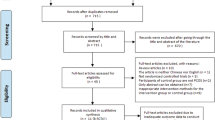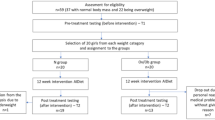Abstract
Objective:
To examine the effect of hypocaloric diet plus sibutramine on body composition, hormonal and metabolic parameters in overweight and obese patients with polycystic ovary syndrome (PCOS).
Design:
Open-label, randomized study at an outpatient clinic.
Patients:
A total of 59 overweight and obese (18–39 years old) women with PCOS.
Measurements:
All patients were placed in a hypocaloric diet plus sibutramine (10 mg per day) for the first month and then on a hypocaloric diet plus sibutramine (10 mg per day, group S) or hypocaloric diet only (group D) for the subsequent 6 months. Body composition, hormonal and metabolic features and insulin sensitivity (oral glucose tolerance test, OGTT) were evaluated at baseline and at 3 and 6 months of treatment.
Results:
Body weight reduced in both groups but the reduction was greater with sibutramine (−15.4±1.1 vs –11.1±1.9% in groups S and D, respectively, P<0.05). At 6 months, a greater percent of patients lost more than 10% of initial body weight in group S than D (81 vs 52.9%). In both groups, all women with abnormal OGTT at baseline presented normal glucose tolerance after 6 months. Free androgen index (FAI), glucose area under the curve and fasting triglyceride (TG) concentration were reduced after 6 months in group S only (P<0.05). No changes in cardiovascular risk factors, prolactin and hepatic enzymes levels were observed in both groups.
Conclusion:
A hypocaloric diet and a diet plus sibutramine both result in significant weight loss in overweight and obese women with PCOS. Patients who received sibutramine showed a greater weight loss and improvement in hyperandrogenemia and insulin sensitivity after 6 months of treatment. The amelioration of insulin resistance in this group could not be totally explained by weight loss. Total testosterone, FAI and TG levels reduction could be a possible mechanism. Finally, sibutramine increased compliance to diet and it was well tolerated from these patients.
This is a preview of subscription content, access via your institution
Access options
Subscribe to this journal
Receive 12 print issues and online access
$259.00 per year
only $21.58 per issue
Buy this article
- Purchase on Springer Link
- Instant access to full article PDF
Prices may be subject to local taxes which are calculated during checkout



Similar content being viewed by others
References
Diamanti-Kandarakis E, Kouli CR, Berqiele AT, Filandra FA, Tsianateli TC, Spina GG et al. A survey of the polycystic ovary syndrome in the Greek island of Lesbos: hormonal and metabolic profile. J Clin Endocrinol Metab 1999; 84: 4006–4011.
The Rotterdam ESHRE/ASRM-sponsored PCOS consensus workshop group. Revised 2003 consensus on diagnostic criteria and long-term health risks related to polycystic ovary syndrome (PCOS). Hum Reprod 2004; 19: 41–47.
Ehrmann AD . Polycystic ovary syndrome. N Engl J Med 2005; 352: 1223–1236.
Sam S, Dunaif A . Polycystic ovary syndrome: syndrome XX? Trends Endocrinol Metab 2003; 14: 365–370.
Asuncion M, Calvo RM, San Millan JL, Sancho J, Avilas S, Escobar-Morreale HF . A prospective study of the prevalence of the polycystic ovary syndrome in unselected Caucasian women from Spain. J Clin Endocrinol Metab 2000; 85: 2434–2438.
Dunaif A, Graf M, Mandeli J, Laumas V, Dobrajansky A . Characterization of groups of hyperandrogenic women with acanthosis nigricans, impaired glucose tolerance and/or hyperinsulinemia. J Clin Endocrinol Metab 1987; 65: 499–507.
Ehrmann DA, Barnes RB, Rosenfield RL, Cavaghan MK, Imperial J . Prevalence of impaired glucose tolerance and diabetes in women with polycystic ovary syndrome. Diabetes Care 1999; 22: 141–146.
Legro RS, Kunselman AR, Dodson WC, Dunaif A . Prevalence and predictors of risk for type 2 diabetes mellitus and impaired glucose tolerance in polycystic ovary syndrome: a prospective, controlled study in 254 affected women. J Clin Endocrinol Metab 1999; 84: 165–169.
Talbott E, Guzick D, Clerici A, Berga S, Detre K, Weimer K et al. Coronary heart disease risk factors in women with polycystic ovary syndrome. Arterioscler Thromb Vasc Biol 1995; 15: 821–826.
Dahlgren E, Johansson S, Johansson L, Lapidus L, Oden A . Polycystic ovary syndrome and risk for myocardial infraction: evaluated from a risk factor model based on a prospective population study of women. Acta Obstet Gynecol Scand 1992; 71: 599–604.
Pierpoint T, McKeigue PM, Isaacs AJ, Wild SH, Jacobs HS . Mortality of women with PCOS at long-term follow-up. J Clin Epidemiol 1998; 51: 581–586.
Meyer C, McGrath BP, Teede HJ . Overweight women with polycystic ovary syndrome have evidence of sub clinical cardiovascular disease. J Clin Endocrinol Metab 2005; 90: 5711–5716.
Kiddy DS, Sharp PS, White DM, Scalon MF, Mason HD, Bray CS et al. Differences in clinical and endocrine features between obese and non-obese subjects with polycystic ovary syndrome: an analysis of 263 consecutive cases. Clin Endocrinol 1990; 32: 213–220.
Huber-Buchholz MM, Carey DG, Norman RJ . Restoration of reproductive potential by lifestyle modification in obese polycystic ovary syndrome: role of insulin sensitivity and luteinizing hormone. J Clin Endocrinol Metab 1999; 84: 2691–2695.
Holte J, Bergh T, Berne C, Wide L, Lithell H . Restored insulin sensitivity but persistently increased early insulin secretion after weight loss in obese women with polycystic ovary syndrome. J Clin Endocrinol Metab 1995; 80: 2586–2593.
Andersen P, Seljeflot I, Abdelnoor M, Arnesen H, Dale PO, Lovik A et al. Increased insulin sensitivity and fibrinolytic capacity after dietary intervention in obese women with polycystic ovary syndrome. Metabolism 1995; 44: 611–616.
Clark AM, Thornley B, Tomlinson L, Galletly C, Norman RJ . Weight loss in obese infertile women results in improvement in reproductive outcome for all forms of fertility treatment. Hum Reprod 1998; 13: 1502–1505.
Moran LJ, Noakes M, Clifton PM, Tomlinson L, Galletly C, Norman RJ . Dietary composition in restoring reproductive and metabolic physiology in overweight women with polycystic ovary syndrome. J Clin Endocrinol Metab 2003; 88: 812–819.
Norman RJ, Davies MJ, Lord J, Moran LJ . The role of lifestyle modification in polycystic ovary syndrome. Trends Endocrinol Metab 2002; 13: 251–257.
Harlass FE, Plymate SR, Fariss BL, Belts RP . Weight loss is associated with correction of gonadotropin and sex steroid abnormalities in the obese anovulatory female. Fertil Steril 1984; 42: 649–652.
Kiddy D, Hamilton-Fairley D, Bush A, Short F, Anyaoku V, Reed MJ et al. Improvement in endocrine and ovarian function during dietary treatment of obese women with polycystic ovary syndrome. Clin Endocrinol 1992; 36: 105–111.
Jayagopal V, Kilpatrick ES, Holding S, Jennings PE, Atkin SL . Orlistat is as beneficial as metformin in the treatment of polycystic ovary syndrome. J Clin Endocrinol Metab 2005; 90: 729–733.
Pasquali R, Gambineri A, Biscotti D, Vicennati V, Gagliardi L, Colitta D et al. Effect of long-term treatment with metformin added to hypocaloric diet on body composition, fat distribution and androgen and insulin levels in abdominally obese women with and without the polycystic ovary syndrome. J Clin Endocrinol Metab 2000; 85: 2767–2774.
Sabuncu T, Harma M, Harma M, Nazligul Y, Kilic F . Sibutramine has a positive effect on clinical and metabolic parameters in obese patients with polycystic ovary syndrome. Fertil Steril 2003; 80: 1199–1204.
Matthews D, Hosker J, Rudenski A, Naylor B, Treacher D, Turner R . Homeostasis model assessment: insulin resistance and β-cell function from fasting plasma glucose and insulin concentrations in man. Diabetologia 1985; 28: 412–419.
Morley JE, Patrick P, Perry III HM . Evaluation of assays available to measure free testosterone. Metabolism 2002; 51: 554–559.
Hansen LD, Toubro S, Stock JM, Macdoland AI, Astrup A . Thermogenic effects of sibutramine in humans. Am J Clin Nutr 1998; 68: 1180–1186.
Robinson S, Chan SP, Franks S . Postprandial thermogenesis is reduced in polycystic ovary syndrome and is associated with increased insulin resistance. Clin Endocirnol 1992; 36: 535–536.
Faria AN, Ribeiro Filho FF, Kohlmann NE, Gouvea Ferreira SR, Zanella MT . Effects of sibutramine on abdominal fat mass, insulin resistance and blood pressure in obese hypertensive patients. Diabetes Obes Metab 2005; 7: 246–253.
Rodrigues AM, Radominski RB, Suplicy Hde L, De Almeida SM, Niclewicz PA, Boguszewski CL . The cerebrospinal fluid/serum leptin ratio during pharmacological therapy for obesity. J Clin Endocrinol Metab 2002; 87: 1621–1626.
Moran LJ, Noakes M, Clifton PM, Tomlinson L, Norman RJ . Dietary composition in restoring reproductive and metabolic physiology in overweight women with polycystic ovary syndrome. J Clin Endocrinol Metab 2003; 88: 812–819.
Stamets K, Taylor DS, Kunselman A, Demers LM, Pelkman CL, Legro RS . A randomized trial of the effects of two types of short-term hypocaloric diets on weight loss in women with polycystic ovary syndrome. Fertil Steril 2004; 81: 630–637.
Tankova T, Dakovska G, Lazarova M, Dakovska L, Kirilov G, Koev D . Sibutramine in the treatment of obesity in type 2 diabetic patients and in nondiabetic subjects. Acta Diabetol 2004; 41: 146–153.
Tambascia M, Geloneze B, Repetto E, Geloneze S, Picolo M, Magro D . Sibutramine enhances insulin sensitivity ameliorating metabolic parameters in a double-blind, randomized, placebo-controlled trial. Diabetes Obes Metab 2003; 5: 338–344.
Bracero N, Zacur HA . Polycystic ovary syndrome and hyperprolactinemia. Obstet Gynecol Clin North Am 2001; 28: 77–84.
Jordan J, Scholze J, Matiba B, Wirth A, Hauner H, Sharma AM . Influence of sibutramine on blood pressure: evidence from placebo-controlled trials. Int J Obes (London) 2005; 29: 509–516.
Hazenberg BP . Randomized, double-blind, placebo-controlled, multicenter study of sibutramine in obese hypertensive patients. Cardiology 2000; 94: 152–158.
Kim SH, Lee YM, Jee SH, Nam CM . Effect of sibutramine on weight loss and blood pressure: a meta-analysis of controlled trials. Obes Res 2003; 11: 1116–1123.
Taieb J, Mathian B, Millot F, Patricot MC, Mathieu E, Queyrel N et al. Testosterone measured by 10 immunoassays and by isotope-dilution gas chromatography-mass spectrometry in sera from 116 men, women, and children. Clin Chem 2003; 49: 1381–1395.
Rosner W, Auchus RJ, Azziz R, Sluss PM, Raff H . Position statement: utility, limitations, and pitfalls in measuring testosterone: an Endocrine Society position statement. J Clin Endocrinol Metab 2007; 92: 405–413.
Author information
Authors and Affiliations
Corresponding author
Rights and permissions
About this article
Cite this article
Florakis, D., Diamanti-Kandarakis, E., Katsikis, I. et al. Effect of hypocaloric diet plus sibutramine treatment on hormonal and metabolic features in overweight and obese women with polycystic ovary syndrome: a randomized, 24-week study. Int J Obes 32, 692–699 (2008). https://doi.org/10.1038/sj.ijo.0803777
Received:
Revised:
Accepted:
Published:
Issue Date:
DOI: https://doi.org/10.1038/sj.ijo.0803777
Keywords
This article is cited by
-
Lifestyle Management for Enhancing Outcomes after Bariatric Surgery
Current Diabetes Reports (2014)



